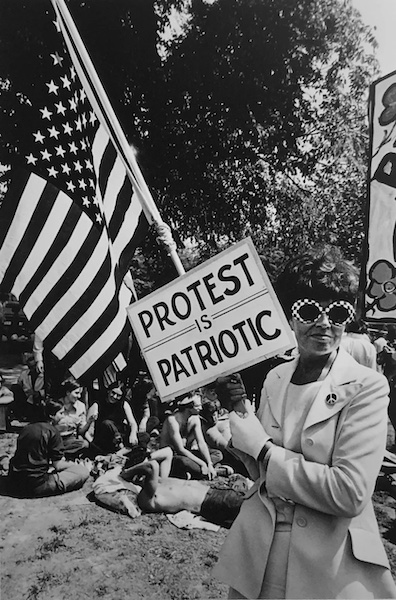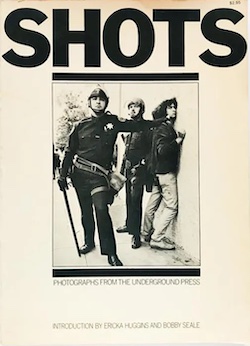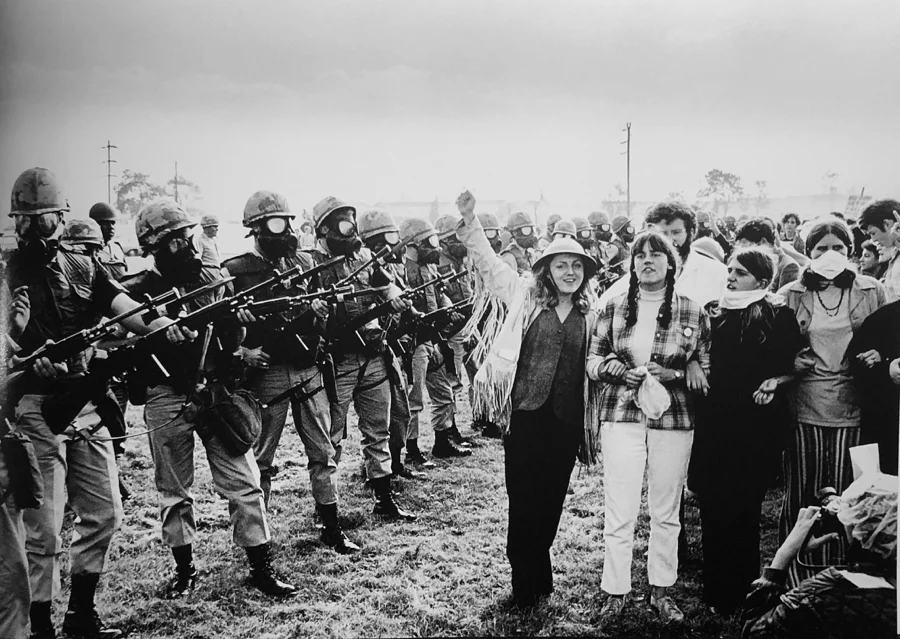
Women demonstrators outside Fort Dix, a major transshipment port for U.S. Army soldiers leaving for Vietnam, October 12, 1969. © David Fenton
Thursday, July 13 from 6:30 PM – 7:30 PM, David Fenton will present his new book The Activist’s Media Handbook: Lessons from Fifty Years as a Progressive Agitator at Book Beat. Copies of his book will be made available for purchase and signing. Read more about David Fenton and his new book below.
Activist, public relations firm founder, and New York native David Fenton started out as a photojournalist in the late 1960’s. His first P.R. campaign took place in Ann Arbor during the effort to free John Sinclair in 1971. He also worked with Sinclair on other issues, lived at his Trans-Love Energies commune, and wrote for the Ann Arbor Sun. In an interview with the Ann Arbor Public Library, Fenton said this about his time there:
It was full of cultural ferment and activism. Lots of social experimentation, and lots of psychedelic and marijuana use. I lived in a commune where nobody had any private property. There were also quite a few community institutions—people were connected.
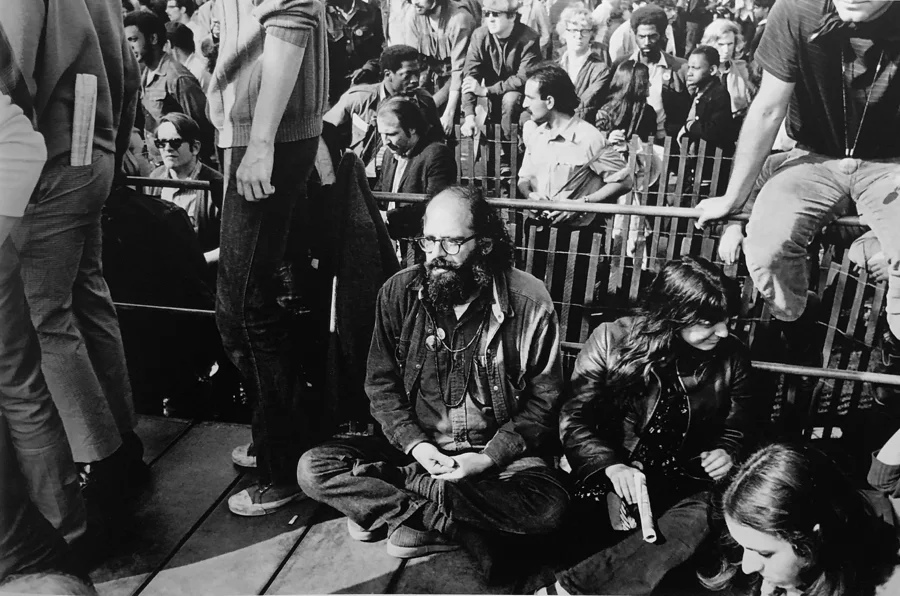
Allen Ginsberg at a rally in support of the Black Panther Party, New Haven, CT, May 1-2, 1970. © David Fenton
About the Activist’s Media Handbook:
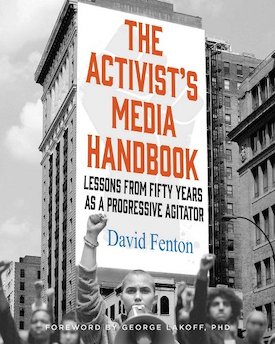 Activist and public relations thought leader David Fenton shares lessons on how to organize successful media campaigns, cultivated from more than half a century working within some of history’s most impactful social movements.
Activist and public relations thought leader David Fenton shares lessons on how to organize successful media campaigns, cultivated from more than half a century working within some of history’s most impactful social movements.
In an extraordinary career David Fenton has learned first-hand what to do–and not to do–to propel progressive causes into the public eye and create real, impactful, lasting change.
A visionary activist, Fenton has been the driving force behind some of the most important and history-making campaigns of the last 50 years, from the No-Nukes concerts with Bruce Springsteen in 1979, to the campaigns to free Nelson Mandela and end apartheid in the late 1980s, exposing the dangers of toxic chemicals in our food, the long battle to legalize marijuana and end racist drug laws, the misinformation in Washington during the Bush era in the 2000s, and recent campaigns that successfully banned fracking in New York and alerted the public to the climate crisis, including the environmental impact of Bitcoin.
Reflecting on his life, with tales of living in a commune, photographing riots and rock stars, working at Rolling Stone and High Times magazines rabble-rousing with Abbie Hoffman, and collaborating with presidents and celebrities, David tells the fascinating story of how he developed the strategies and tactics that have made him a successful media agitator. David then shows how these tools can be used by anyone to advance their cause.
Part rollercoaster memoir, part practical guide, The Activist’s Media Handbook provides an essential toolkit for today’s activists for organizing to win: how to tell your story, captivate audiences, and inspire them to join the cause.
You can learn more about Fenton’s work and this book in a this short video:
All Power to the straight Shooters!
Many of David Fenton’s finest images were distributed through the Liberation News Service and appeared on the pages of hundreds of small alternative presses throughout the late ’60s and early ’70s. His photo work also appeared in The New York Times, Life, Time, Look, Newsweek, and the Saturday Review.
Fenton’s first book Shots: Photographs from the Underground Press, was published in 1971 and was dedicated to his friend and mentor, the humorist/activist Abbie Hoffman who titled the book. At the time Shots was published, few protest photobooks existed. An expanded high quality second edition of Shots was released by Earth Aware Editions in four-color qudratone in 2005. Although also long out-of-print it remains one of the most beautifully printed photobooks of late ’60s progressive politics to date.
“The late 60s and early 70s were a turbulent time of civil unrest in American history, when people were confronted by tragedy, war and a divided nation. Photographer David Fenton, then a teenage high school dropout turned full-time photographer for Liberation News Service (LNS), captured the tumultuous times when the images truly spoke louder than the headlines. Through his photographs, Fenton gave us an inside view of Vietnam anti-war and draft resistance demonstrations, a Central Park “Be-In” with Abbie Hoffman, the trials of Black Panther Party leaders, a Janis Joplin concert and other signs of the times. Because LNS was a part of Students for a Democratic Society (SDS), Fenton had access to people and places that other mainstream media photographers didn’t, and was the only photographer allowed to photograph the infamous Weather Underground.”
~Washington Life Magazine
A small gallery of pages from Shots are posted at the site: Protest in Photobooks.
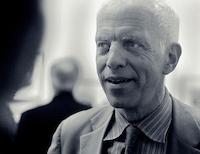 David Fenton (b. 1953) is founder and Chairman of Fenton Communications. Fenton’s best-known campaigns include aiding the rise of MoveOn.org and organic food sales, representing Nelson Mandela and the African National Congress, passing sanctions against apartheid, saving swordfish from extinction, working with Al Gore and the United Nations on climate change and many others. Named “one of the 100 most influential P.R. people” by PR Week and “the Robin Hood of public relations” by The National Journal, founded Fenton in 1982 to create communications campaigns for the environment, public health and human rights. Over four decades he has pioneered the use of PR, social media and advertising techniques for social change. Fenton started his career as a photojournalist in the late 1960s. He was formerly Director of Public Relations at Rolling Stone magazine and Co-Producer of the No-Nukes concerts in 1979 at Madison Square Garden with Bruce Springsteen, Bonnie Raitt, James Taylor, Jackson Browne and other artists. David is a native of Manhattan where he lives with his wife and two teenagers. He is featured in the films The U.S. vs. John Lennon (2006) and The MoveOn.org Story (2009). He has also published a book of photographs, Shots: An American Photographer’s Journal 1967-1972.
David Fenton (b. 1953) is founder and Chairman of Fenton Communications. Fenton’s best-known campaigns include aiding the rise of MoveOn.org and organic food sales, representing Nelson Mandela and the African National Congress, passing sanctions against apartheid, saving swordfish from extinction, working with Al Gore and the United Nations on climate change and many others. Named “one of the 100 most influential P.R. people” by PR Week and “the Robin Hood of public relations” by The National Journal, founded Fenton in 1982 to create communications campaigns for the environment, public health and human rights. Over four decades he has pioneered the use of PR, social media and advertising techniques for social change. Fenton started his career as a photojournalist in the late 1960s. He was formerly Director of Public Relations at Rolling Stone magazine and Co-Producer of the No-Nukes concerts in 1979 at Madison Square Garden with Bruce Springsteen, Bonnie Raitt, James Taylor, Jackson Browne and other artists. David is a native of Manhattan where he lives with his wife and two teenagers. He is featured in the films The U.S. vs. John Lennon (2006) and The MoveOn.org Story (2009). He has also published a book of photographs, Shots: An American Photographer’s Journal 1967-1972.

